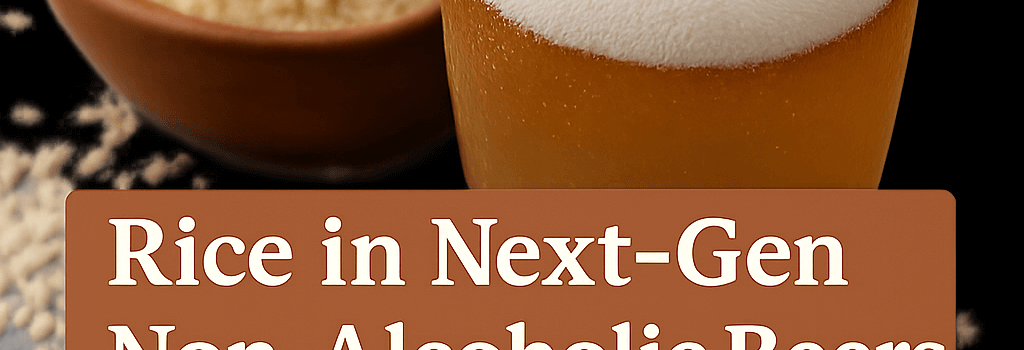Rice in Next-Gen Non-Alcoholic Beers: A Technical Overview

Introduction
As global demand for low- and non-alcoholic beers surges—projected to exceed $30 billion by 2030[1]—brewers are reevaluating traditional ingredients and processes to boost flavor, stability, and efficiency. Recent peer-reviewed studies in the International Journal of Food Properties and the Journal of the American Society of Brewing Chemists highlight milled rice as a powerful adjunct to barley malt, challenging century-old brewing conventions.
Why Rice?
Rice brings multiple advantages to non-alcoholic beer production:
- Starch Composition: Selected cultivars with 15–20% amylose and low gelatinization temperatures (60–65 °C) release fermentable sugars more readily during mashing.
- Lower Aldehydes: Substituting up to 70% barley malt with rice reduces worty off-flavors by 30–50% via decreased Strecker aldehyde formation.
- Clean Flavor: Neutral rice matrices can be tuned—using aromatic or nonaromatic strains—to yield vanilla, buttery, or ultra-neutral profiles.
Key Findings from Recent Studies
-
Fermentation Kinetics: Increased rice ratios boosted free glucose and fructose concentrations by 20–40%, shortening primary fermentation by 12–18 hours.
“Higher simple-sugar availability accelerates yeast metabolism without overshooting the 0.5% ABV threshold,” notes Dr. Scott Lafontaine, University of Arkansas.
- Flavor and Mouthfeel: Sensory panels in the US and Europe found 70% rice blends delivered a creamier mouthfeel—attributed to elevated higher-order alcohols (fusel alcohols) that remain under non-alcoholic limits.
- Extract Yields Across 74 Cultivars: Varieties with sub-20% amylose and milling friability indexes above 75% reached extract yields of 85–90% (w/w), reducing grain costs by ~10%.
Regulatory Landscape and Incentives
Germany’s Reinheitsgebot still restricts beer ingredients to barley malt, hops, water, and yeast, resulting in non-alcoholic brews with pronounced “worty” character due to elevated aldehyde levels. Conversely, the US permits adjuncts like rice, spurring state initiatives. In April 2025, Arkansas passed legislation offering tax credits up to 15% for breweries sourcing local rice and deploying it in sake or beer production.
Process Engineering and Enzymatic Optimization
Integrating rice requires precise control of mashing parameters and enzyme dosing:
- Dual-Stage Mashing: First rest at 50 °C to activate proteases, improving FAN (Free Amino Nitrogen) for yeast health; second rest at 62–65 °C to optimize β-amylase for maltose release from rice starch.
- Exogenous Amylases: Commercial 100 LL alpha-amylase and beta-amylase preparations ensure complete degradation of long-chain amylopectin, elevating fermentable sugar yield by up to 8%.
- pH Control: Maintaining mash pH at 5.2–5.4 enhances enzyme stability and limits Maillard-derived aldehydes.
“Precise enzymatic profiles are critical when you push rice levels above 50%,” explains Maria Rossi, head brewer at Nexa Hops & Grains. “It’s not just grain substitution—it’s a tailored bioprocess.”
Genomic Innovations in Rice Varietal Development
Advances in genomics and high-throughput phenotyping are accelerating the creation of rice cultivars ideally suited for brewing:
- GWAS and Marker-Assisted Selection: Identification of QTLs linked to gelatinization temperature and milling yield enables breeders to stack favorable alleles.
- CRISPR-Cas9 Editing: Targeted mutations in the Wx gene can adjust amylose/amylopectin ratios, delivering tailor-made starch profiles.
- Phenomic Screening: Automated imaging and rheology assays evaluate 1,000+ lines per season for kernel integrity, friability, and gelatinization kinetics.
Sustainability and Market Dynamics
Rice’s water and land footprint differ significantly from barley. Lifecycle assessments show:
- Water Use: Aerobic paddy versus rainfed systems can be optimized to reduce overall irrigation by 15–20%.
- Carbon Emissions: Local sourcing in the US Mid-South cuts logistics CO₂ by up to 25% compared to imported barley malt.
- Economic Impact: Incentivizing rice cultivation for brewing diversifies farmer incomes and stabilizes grain markets.
Expert Perspectives and Future Outlook
Industry leaders predict further convergence of brewing science and cereal chemistry:
- Dr. Sven Kubitz, RI for Raw Materials (Berlin): “Next-generation non-alcoholic beers will leverage synthetic biology to customize flavor precursors directly in the grain.”
- Jane Liu, Director of R&D at BioMash Tech: “Fermentation in continuous bioreactors, coupled with high-gravity rice worts, could slash production time by 30% and reduce energy consumption.”
Conclusions
Rice is far more than a neutral filler; it is a versatile substrate for brewing innovation. By combining tailored rice cultivars, optimized enzymatic protocols, and sustainable sourcing, breweries can craft non-alcoholic beers with superior flavor, mouthfeel, and production efficiency. As regulatory frameworks evolve—both in the US and potentially within a future EU revision of the Reinheitsgebot—the industry stands on the cusp of a radical transformation.
References:
[1] “Global Non-Alcoholic Beverages Market Report,” MarketInsights, April 2025.
Original Studies:
International Journal of Food Properties (2025). DOI: 10.1080/10942912.2025.2520907
Journal of the American Society of Brewing Chemists (2025). DOI: 10.1080/03610470.2025.2499768